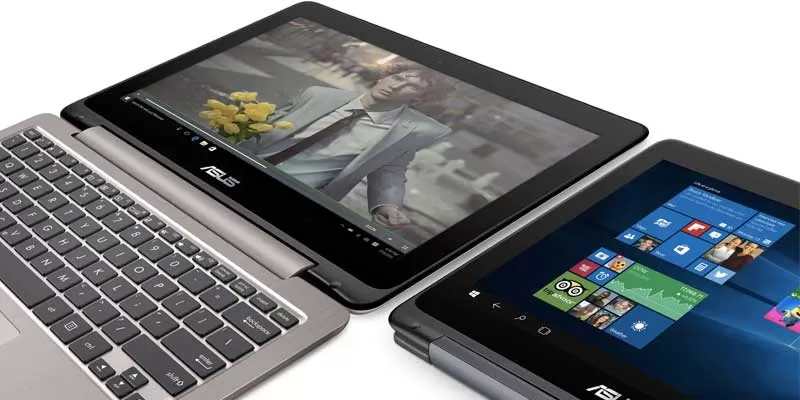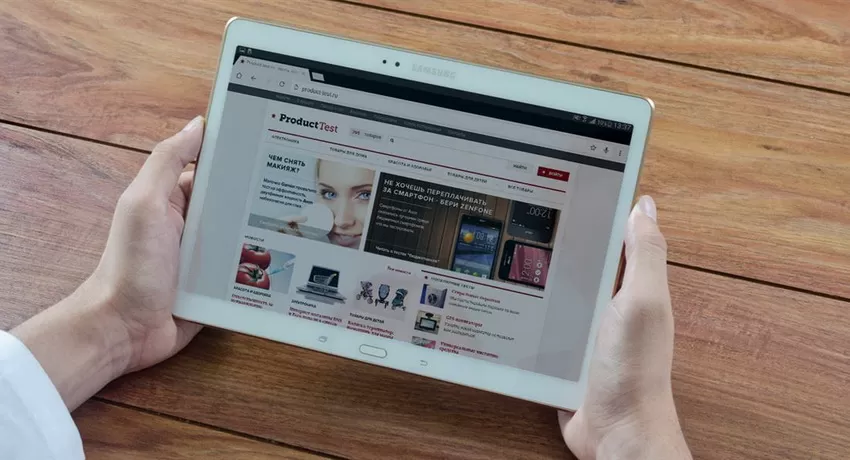
Comparing a laptop and a tablet with a keyboard
According to tablet manufacturers, in the age of modern technology, their products can completely replace conventional laptops in work, play, and household areas.
At first glance, this is true: on a tablet, you can watch movies, type texts, work in programs similar to those that can be installed on a laptop. From it you can go online and play games, draw and animate videos.
But if you take a closer look and compare the key characteristics, things start to look quite different.

Dimensions and compactness
The first and most obvious criterion by which a comparison can be made is the dimensions and weight:
Tablets. Small devices from this category have a screen diagonal of only 7 inches — that is, 17 and a half centimeters. In practice, they are slightly larger than the palm of an adult man of average height, fit freely in the inside pocket of a jacket, and rarely exceed 400 grams in weight. Larger tablets reach 10 inches — that is, 25 centimeters. You can’t put such a device in your bosom, but it fits easily into an ordinary backpack or bag. Weight — 600 grams with variations, depending on what the case is made of (it can be either plastic or metal).
Notebooks. The screen diagonal of a laptop is larger, it usually starts from 12 inches and gains acceleration to almost 20. The weight is also appropriate — a super-thin and super-light laptop was recently introduced to the public, weighing 840 grams. Ordinary devices weigh, as a rule, not less than one and a half kilograms. You can carry them in a backpack or in a special bag, which in themselves have additional weight, since they have special pads to soften a possible impact.
Simply put, according to the first criterion, tablets unconditionally win: they are much easier to carry with you everywhere, they do not take up much space and do not attract attention. He got it — did what he wanted — removed it.
Screen
The next criterion is screen size and image quality. The correlation, of course, is preserved:
-
Tablets. Diagonal from 7 to 10 inches. Image quality is good, sometimes even better than laptops, but at this size it’s not too noticeable: to see small details, you need to look closely or adjust the magnification.
-
Notebooks. The diagonal is from 12 to 15 inches, although there are also giants of 17 inches. The picture quality is standard, sometimes inferior to the tablet. But on the laptop screen it is much easier to work with small details.
According to the second criterion, it is difficult to give a clear score to one thing. For fine detail work, a laptop is better (it is also better for people with low vision), but in other cases, a portable device wins, since its small screen is the key to compactness. The result is a draw.
In the overall score, tablets still lead the way.
Input Devices
If we compare a laptop and a regular tablet in terms of ease of entering information, the victory will be for the first. Because:
-
Tablets. Working with the on-screen keyboard and stylus is a hassle. They are convenient to manipulate when you need to type a short post, view a photo, turn on a movie or draw something. But in photo editors, text editors, in software that helps you work with tables and presentations, and any similar programs that require precise movements, it is much harder to work from a portable device.
-
Notebooks. They have a touchpad and a conveniently sized built-in keyboard. You can connect a mouse to them — regular or wireless. From the point of view of work, it is much more convenient and familiar to most users.
However, when it comes to tablets that can be connected to third-party devices, everything changes dramatically: the advantage of laptops is completely leveled, since you can connect a mouse and keyboard to them in the same way and work with convenience.
Often a keyboard is included with such devices, and if not, it can be easily purchased. A special chic is a keyboard that folds up and is worn in a tube. It takes up very little space, it is quite convenient to work with it, plus it looks interesting.
According to the third criterion, it’s a draw again, but this time with a slight advantage in the direction of laptops — they already have everything in the kit, no need to spend extra money on a keyboard.
Battery Life
Both tablets and laptops can be taken with you. But here are enough of them for different working hours:
-
Tablets. Usually they have capacious batteries that are resistant to environmental influences. A fully charged device will last 12 hours — and this time can be spent actively browsing the Internet, playing something, listening to music, watching movies or drawing. If you leave the device in standby mode, with the Internet search turned off, it can lie for several weeks at all, since the battery is not wasted in the process.
-
Notebooks. With laptops it’s different: they require much more energy, and no matter how capacious the battery is, it lasts for a maximum of 8 hours. And often even less, especially if you turn the screen brightness to high values and engage in vigorous activities: watch movies, play games or work. When the battery runs out a little, it will start to last for about three hours without recharging.
It is better to go hiking with a tablet. And it’s worth taking a laptop with you only in the city, where there are outlets nearby and where you can recharge.
However, most people use a laptop as a desktop computer and do not suffer from low battery capacity.
Memory sizes
Memory is, in fact, the brain of the device. And, if we compare by this criterion, it turns out that laptops are much smarter than tablets:
-
Tablets. The amount of built-in memory is usually from 2 to 32 gigabytes. It is clear that very little information fits into it, because even a film in the most average quality does not weigh less than 2 gigabytes, let alone games and programs. With RAM, a little more joyful, but still not much — from 2 to 4, sometimes there are «monsters» with a memory of 6. Usually this is enough to provide at least some speed.
-
Notebooks. The amount of built-in memory is a minimum of 256 gigabytes, and the maximum can be up to a terabyte. Movies, and games, and music, and programs will fit, and, if anything, you can even buy an external drive, which will cost 3,000 for a volume of 500 GB. RAM varies depending on the brand and «tricks» from 2 to 16 gigabytes. Most laptops are more powerful than portable devices, although they are inferior in performance to desktop computers.
Of course, tablet manufacturers are trying to compensate for the small amount of internal memory by offering users to buy additional flash drives that expand it. But their price is much higher than that of external hard drives and can reach up to 1000 for 32 GB and up to 10,000 for 256. The deal turns out to be unprofitable.
According to this criterion, laptops cut tablets clean.
Ability to connect external devices
The ability to connect external devices to equipment is very useful:
-
Tablets. They cannot boast of such an opportunity: most simply do not have a connector to connect using wires. Everything that can be connected to them is connected via bluetooth, and this method is considered unreliable and the devices that work with it are usually more expensive.
-
Notebooks. On the contrary, you can connect virtually anything to them: a printer, TV, DVD player, speaker system, headphones, flash drives, and for all this it is enough to plug the connector into the port, of which there is more than one.
Recently, tablets have been actively moving towards being able to connect to external devices, but so far this is only a movement, the results of which are not very impressive.
Software
Programs allow you to work, play, be creative. If memory is the brain, then programs are the hands:
-
Tablets. The software is being actively updated, but there is one «but». First, most tablet programs are adapted from computers, and this is often clumsily done. Secondly, it cannot be found online for free — both Android and iOs make sure that users do not engage in piracy. Thirdly, in most of the programs you need to work on a tablet, even with a keyboard, it’s not very convenient to work. For example, interact with a text editor, manipulate Excel, or prepare presentations. -
laptops. The software is so extensive that most users will always find what they need for work and leisure. Under Windows, a huge number of utilities are imprisoned, you can write, draw, play, make presentations and tables, and build drawings from it.
In addition, in order for the tablet to pull the software available to the laptop at the same level, it must be similar to it in terms of characteristics. This means that it must have a large RAM, which means that it will be much more expensive than the budget segment.
In fact, it is quite possible to work on a tablet, but it will not be so convenient and you will have to spend both time on setting up and money on a purchase.
Important! Most of the games that have been released so far are for computers and not for tablets. Because the choice of gamers is obvious immediately. The rest may fluctuate.
Other criteria
Tablets have several specific advantages that a laptop does not have:
-
they are stronger — the body is often made of metal, a tablet that has been dropped will not necessarily break, a tablet that has been sat on may well survive if it was lying screen down;
-
they have cameras — and in a laptop there is only a front-facing camera, you can’t shoot anything from it except your own face;
-
they are mobile — it is easier to get out of the house with them and on the road they can replace a navigator, a book, a player, and partially even a phone.
In addition, the tablet can act as a fashion accessory. But laptops are usually used only for practical purposes.
Brief squeeze
Summing up, it becomes clear that advantages and disadvantages depend largely on the point of view. However, it will still be useful to highlight them in the list.
Pros and cons of laptops

Laptops have the following advantages:
-
A large amount of memory, both built-in and operating. Therefore, they can store more information, process requests faster, and are more likely to handle the right software than tablets.
-
Large screen. It shows fine details better and makes it easier to work in programs that require concentration. For people with low vision, this plus is completely defining.
-
Ability to connect external devices. And much more convenient than tablets. You can connect a printer, TV, DVD, speaker system and many other useful devices.
-
Large selection of software and familiar to users of Windows. You can put programs on it for every taste — for creativity, for work and for leisure. Most of the games, especially the old ones, are imprisoned for it.
But they also have disadvantages:
-
Dimensions and weight. The smallest laptops in existence weigh 840 grams, while conventional models often go over 1.5 kilograms. The dimensions are such that you will have to buy a separate bag for a laptop, which can be quite heavy.
-
Small battery capacity. It only lasts for 8 hours of battery life — and this is the maximum. A figure of 5-6 hours looks much more realistic.
-
Inconvenience of use. You won’t get into bed with a laptop, you won’t get comfortable in transport. He is bulky, you still need to find a position in which it will be pleasant to work with him, in addition to the standard “sitting at the table” position.
-
Large power supply. In size, it is at least a couple of times larger than the size of the tablet’s power supply, and it will require space in your bag.
-
In general, a laptop is a good replacement for a desktop PC for people who often move or visit friends in another city from time to time. Working with it is definitely more convenient than with a tablet with a keyboard.
Pros and cons of tablets

Tablets have the following advantages:
-
Compactness. The maximum size of the tablet is 10 inches, the maximum weight is 800 grams. To carry it with you, a cover is enough for it and for the keyboard, you don’t have to buy any separate bag.
-
Capacious battery. In standby mode, the tablet can lie for a week or two, and with active use it will be discharged in 12 hours. Such a period of time beats the results of laptops easily.
-
Ease of use. It is easy to sit or lie down with the tablet, it is pleasant to get it in transport and can be positioned as you want. And if you need to connect a keyboard, you can use the table.
Of course, there are also disadvantages:
-
Poor fitness for work. From a small screen and a small keyboard, working with text, tables or drawings is a real torment. In addition, often the analogues of the necessary programs are not adapted well enough or the tablet slows down because it does not have enough memory.
-
The inability to connect many external devices at once. And some of them cannot be used at all — for example, a TV.
-
Less repairable. In most cases, the tablet is easier to replace than to repair. And, of course, it will not be possible to upgrade it by adding a memory chip or replacing the processor — it is simply not suitable for this.
-
Small amount of memory. What is built-in, what is operating. Moreover, it is difficult and expensive to expand it — microSD flash drives are small in volume and their price is high, and it will not work at all to build in RAM.
-
The tablet is good for hobbies and entertainment. It is nice to lie in bed with him or go hiking without fear of getting lost. But at the same time, it is not well suited for serious work, even with a keyboard.
Final Choice
The final choice should be made based on your needs:
-
A laptop is good if you plan to work with it or play PC games. It is large, comfortable, it runs most of the programs and it can be upgraded if necessary.
-
The tablet is good if it is needed for hobbies, creativity and leisure. It’s nice to listen to music, watch movies while lying on the couch, and play simple games like match-3. It is not suitable for work, even if you attach a keyboard to it.
-
But, of course, everyone decides for himself — you can always go to a computer store, feel laptops, tablets, and keyboards for tablets there and, based on empirical experience, make your own choice.
Добавить комментарий
Для отправки комментария вам необходимо авторизоваться.